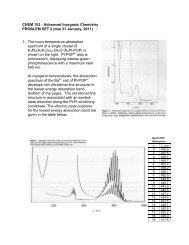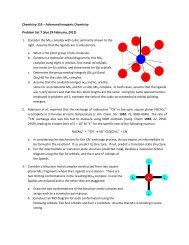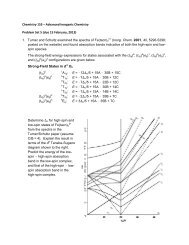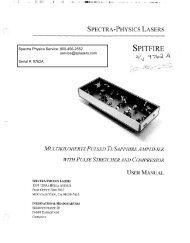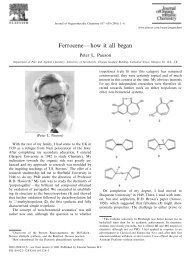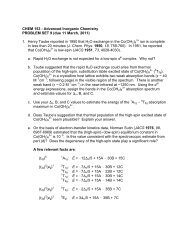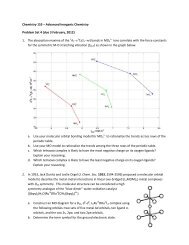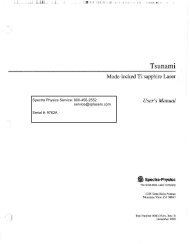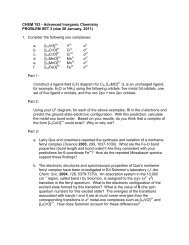NESLAB System III ystem III
NESLAB System III ystem III
NESLAB System III ystem III
Create successful ePaper yourself
Turn your PDF publications into a flip-book with our unique Google optimized e-Paper software.
<strong>NESLAB</strong><br />
<strong>S<strong>ystem</strong></strong> <strong>III</strong><br />
Heat Exchanger<br />
Thermo Manual P/N U00678 Rev. 08/19/05<br />
Installation-Operation-<br />
Basic Service<br />
Visit our Web site at:<br />
http://www.thermo.com/tc<br />
Product Service Information, Applications<br />
Notes, MSDS Forms, e-mail.<br />
Voice Info: (800) 258-0830
Thermo Electron Corporation<br />
Control Technologies<br />
25 Nimble Hill Road<br />
Newington, NH 03801<br />
(800) 258-0830 or<br />
(603) 436-9444<br />
Fax : (603) 436-8411<br />
Netherlands<br />
Takkebijsters 1<br />
Breda 4817 BL<br />
Netherlands<br />
Tel : +31 76 587 9888<br />
Fax : +31 76 579 5610<br />
Control Technologies<br />
Main Service Center<br />
The Main Service Center is open<br />
8:00 am to 5:00 pm (Eastern<br />
Time), Monday through Friday.<br />
Thermo <strong>NESLAB</strong><br />
25 Nimble Hill Road<br />
Newington, NH 03801<br />
(800) 258-0830 or<br />
(603) 436-9444<br />
Fax : (603) 436-8411<br />
Germany<br />
Dieselstrasse 4<br />
Karlsruhe 76227<br />
Germany<br />
Tel : +49 (0) 721 4094 0<br />
Fax : +49 (0) 721 4094 300<br />
West Coast<br />
355 River Oaks Parkway, Door 10<br />
San Jose, CA 95134<br />
United States<br />
Tel : (800) 423-7831 or<br />
(408) 965-6050<br />
Fax : (408) 965-6051<br />
France<br />
16 Avenue du Québec - Silic 765<br />
Courtaboeuf Cédex 91963<br />
France<br />
Tel : 33 (0) 1 60 92 48 00<br />
Fax : 33 (0) 1 60 92 49 00<br />
South<br />
8711 Burnet Road<br />
Suite F69<br />
Austin, TX 78757-7065<br />
(512) 459-2167<br />
Fax : (512) 459-1731<br />
United Kingdom<br />
Ion Path, Road Three<br />
Winsford CW7 3GA<br />
United Kingdom<br />
Tel : +44 1606 548749<br />
Fax : +44 1606 548712<br />
© 2005 Thermo Electron Corp. 623-2087<br />
All rights reserved. This document is for informational purposes only and is<br />
subject to change without notice.
<strong>S<strong>ystem</strong></strong> <strong>III</strong> Liquid to Liquid Heat Exchanger<br />
Instruction and Operation Manual<br />
Table of Contents<br />
PREFACE<br />
SECTION I<br />
Safety<br />
SECTION II<br />
General Information<br />
SECTION <strong>III</strong><br />
Installation<br />
SECTION IV<br />
Operation<br />
Compliance ............................................................................................ 3<br />
WEEE Compliance ................................................................................. 3<br />
Unpacking .............................................................................................. 4<br />
Warranty................................................................................................. 4<br />
NES-care ................................................................................................ 4<br />
After-sale Support ................................................................................... 4<br />
Feedback ............................................................................................... 4<br />
Warnings ................................................................................................ 5<br />
Description ............................................................................................. 6<br />
Specifications ......................................................................................... 6<br />
Site......................................................................................................... 8<br />
Facility Water Requirements................................................................... 8<br />
Electrical Requirements .......................................................................... 9<br />
Voltage Selection ................................................................................... 9<br />
Plumbing Requirements .......................................................................... 9<br />
Fluids ..................................................................................................... 10<br />
Filling Requirements ............................................................................... 11<br />
Automatic Refill Device (Optional) ........................................................... 11<br />
Flow Control ........................................................................................... 11<br />
Auto Restart ........................................................................................... 11<br />
Start Up .................................................................................................. 12<br />
Temperature Controller ............................................................................ 13<br />
Setup Loop ............................................................................................. 14<br />
- 1 -
SECTION V<br />
Maintenance& Service<br />
SECTION VI<br />
Troubleshooting<br />
SECTION VII<br />
Diagrams<br />
APPENDIX<br />
Service Contracts ................................................................................... 15<br />
Pump Strainer ........................................................................................ 15<br />
Facility Water Strainer ............................................................................ 15<br />
Algae ...................................................................................................... 16<br />
Configuration ........................................................................................... 16<br />
Voltage Selection ................................................................................... 16<br />
Pressure Relief Valve .............................................................................. 16<br />
Fault Interlock Contact ............................................................................ 17<br />
Fuses ..................................................................................................... 17<br />
Phase Rotation ....................................................................................... 17<br />
Pump Motor Overload Protector .............................................................. 17<br />
Displaying Software Version ................................................................... 18<br />
Error Codes ............................................................................................ 19<br />
Poor Temperature Stability ..................................................................... 20<br />
Service Assistance ................................................................................. 20<br />
Parts List ................................................................................................ 20<br />
TU Pump Flow Diagram .......................................................................... 21<br />
Front View .............................................................................................. 22<br />
Rear View ............................................................................................... 22<br />
Large Volume Units ................................................................................ 23<br />
Water Quality and Standards<br />
WARRANTY<br />
- 2 -
Compliance<br />
Preface<br />
Products tested and found to be in compliance with the requirements defined in the EMC<br />
standards defined by 89/336/EEC as well as Low Voltage Directive (LVD) 73/23/EEC can be<br />
identified by the CE label on the rear of the unit. The testing has demonstrated compliance with<br />
the following directives:<br />
LVD, 73/23/EEC Complies with UL 3101-1:93<br />
EMC, 89/336/EEC<br />
EN 55011, Class A Verification<br />
EN 50082-1:1992<br />
IEC 1000-4-2:1995<br />
IEC 1000-4-3:1994<br />
IEC 1000-4-4:1995<br />
For any additional information refer to the Letter of Compliance that shipped with the unit<br />
(Declaration of Conformity).<br />
WEEE Compliance<br />
This product is required to comply with the European Union’s Waste Electrical & Electronic<br />
Equipment (WEEE) Directive 2002/96/EC. It is marked with the following symbol:<br />
Thermo Electron has contracted with one or more recycling/disposal companies in each EU<br />
Member State, and this product should be disposed of or recycled through them. Further<br />
information on Thermo Electron’s compliance with these Directives, the recyclers in your<br />
country, and information on Thermo Electron products which may assist the detection of<br />
substances subject to the RoHS Directive are available at:<br />
www.thermo.com/WEEERoHS<br />
- 3 -
After-sale Support<br />
Thermo Electron Corporation is committed to customer service both during and after the sale. If<br />
you have questions concerning the operation of your unit, contact our Sales Department. If your<br />
unit fails to operate properly, or if you have questions concerning spare parts, contact our<br />
Customer Service Department. Before calling, please obtain the following information:<br />
- BOM number<br />
- Serial number<br />
- Software version<br />
The BOM and serial number are on a label on the rear of the unit. To display the software<br />
version see page 17.<br />
Unpacking<br />
Warranty<br />
Retain all cartons and packing material until the unit is operated and found to be in good<br />
condition. If the unit shows external or internal damage contact the transportation company and<br />
file a damage claim. Under ICC regulations, this is your responsibility.<br />
Units have a warranty against defective parts and workmanship for one full year from date of<br />
shipment. See back page for more details.<br />
NES-care Extended<br />
Warranty Contract<br />
• Extend parts and labor coverage for an additional year.<br />
• Worry-free operation.<br />
• Control service costs.<br />
• Eliminate the need to generate repair orders.<br />
• No unexpected repair costs.<br />
Other contract options are available. Please contact Thermo us for more information.<br />
Feedback<br />
We appreciate any feedback you can give us on this manual. Please e-mail us at<br />
neslabmanuals@thermo.com. Be sure to include the manual part number and the revision date<br />
listed on the front cover.<br />
- 4 -
Section I Safety<br />
Warnings<br />
Make sure you read and understand all instructions and safety precautions<br />
listed in this manual before installing or operating your unit. If you have any<br />
questions concerning the operation of your unit or the information in this<br />
manual, contact our Sales Department.<br />
Performance of installation, operation, or maintenance procedures<br />
other than those described in this manual may result in a hazardous<br />
situation and may void the manufacturer's warranty.<br />
Observe all warning labels.<br />
Never remove warning labels.<br />
Never operate damaged or leaking equipment.<br />
Always turn off the unit and disconnect the line cord from the power<br />
source before performing any service or maintenance procedures, or<br />
before moving the unit.<br />
Always empty the reservoir before moving the unit.<br />
Never operate equipment with damaged line cords.<br />
Never operate without fluid.<br />
Refer service and repairs to a qualified technician.<br />
In addition to the safety warnings listed above, warnings are posted throughout<br />
the manual. These warnings are designated by an exclamation mark inside an<br />
equilateral triangle with text highlighted in bold print. Read and follow these<br />
important instructions. Failure to observe these instructions can result in<br />
permanent damage to the unit, significant property damage, or personal injury<br />
or death.<br />
- 5 -
Section II General Information<br />
Description<br />
The <strong>NESLAB</strong> <strong>S<strong>ystem</strong></strong> <strong>III</strong> Liquid to Liquid Heat Exchanger is designed to<br />
remove heat from water-cooled instruments. The unit consists of a heat<br />
exchanger, recirculation pump, PVC reservoir, and a microprocessor controller.<br />
Specifications<br />
Temperature Range<br />
Temperature Stability<br />
Cooling Capacity 1<br />
70<br />
+5°C to +40°C<br />
±1.0°C<br />
Pressure Drop (PSI)<br />
1 2 2.4 3.5 5 6 8 10<br />
60<br />
Heat Removal (KW)<br />
50<br />
40<br />
30<br />
A<br />
B<br />
C<br />
20<br />
10<br />
A= 6gpm pump flow<br />
B= 10 gpm pump flow<br />
C= 12gpm pump flow<br />
5 10 15 20 25<br />
Facility Water Flow GPM<br />
Reservoir Volume 2<br />
Gallons<br />
Liters<br />
Dimensions 3<br />
(H x W x D)<br />
Inches<br />
Centimeters<br />
Shipping Weight 4<br />
Pounds<br />
Kilograms<br />
1.25<br />
4.7<br />
20¾ x 17 3 /8 x 27<br />
52.7 x 44.1 x 68.6<br />
206<br />
93.4<br />
1. Cooling capacity is based in a 10°C difference between the temperature of the cooling<br />
water<br />
supply and the cooling fluid flowing from the <strong>S<strong>ystem</strong></strong> <strong>III</strong><br />
to the instrument being cooled (see<br />
Section <strong>III</strong>, Facility Water Requirements). Pressure drop obtained with the <strong>S<strong>ystem</strong></strong> <strong>III</strong> modulating<br />
valve fully open.<br />
2. Larger volume reservoir units are available.<br />
3. Units with CP-55 and TU-3 pumps. Other larger volume units measure 33¾ x 23 x 27¼<br />
(85.7 x 58.4 x 69.2). For complete dimensions see pages 22-23.<br />
4. Approximate. Larger volume units weigh approximately 355 pounds (161 kilograms).<br />
- 6 -
Pump Capacity 5,6<br />
70<br />
60<br />
50<br />
A<br />
Pressure (psi)<br />
40<br />
30<br />
20<br />
10<br />
D<br />
C<br />
B<br />
E<br />
F<br />
A=TU-7, 60Hz<br />
B=TU-7, 50Hz<br />
C=TU-3, 60Hz<br />
D=TU-3, 50Hz<br />
E=CP-55, 60Hz<br />
F=CP-55, 50HZ<br />
5 10 15 20<br />
Flow (gallons/minute)<br />
5.TU-7, TU-8, and TU-9 pumps require 3Ø power.<br />
6.TU-5 pumps are rated 9 gpm @ 50 psi, TU-6 pumps are 12 gpm @ 50 psi, TU-8 pumps<br />
are 20 gpm @ 50 psi, and TU-9 pumps 23 gpm @ 50 psi.<br />
- 7 -
Section <strong>III</strong> Installation<br />
Site<br />
The unit should be located in a laboratory or clean industrial environment with<br />
easy access to a facility cooling water supply and a drain. Never place the unit<br />
in a location where excessive heat, moisture, or corrosive materials are<br />
present.<br />
Refer to the pump label on the rear of the unit to identify the specific type of<br />
pump in your unit. Units with a TU-7, TU-8 or TU-9 pump are equipped with a<br />
pump motor fan. The fan is used to cool the pump motor and prevent the motor<br />
from overheating. Air is drawn through the front of the unit and is discharged<br />
through the rear of the unit. A minimum clearance of 6 inches (0.15 meters) at<br />
the front and rear of the unit is necessary for ventilation.<br />
Facility Water<br />
Requirements<br />
Limit the facility water inlet pressure to less than 150 psi (10,2 Bar) and<br />
limit the facility water inlet pressure to outlet pressure differential<br />
across the <strong>S<strong>ystem</strong></strong> <strong>III</strong> to less than 35 psid (2,4 Bar).<br />
Refer to the Cooling Capacity chart in Section II, Specifications. The flow rate of<br />
the cooling water supply must meet or exceed these requirements for the unit<br />
to operate at its full rated capacity. If the cooling water does not meet these<br />
standards, the cooling capacity will be derated. The chart is based on a<br />
difference between the temperature of the cooling water supply (House Water)<br />
and the cooling fluid flowing from the <strong>S<strong>ystem</strong></strong> <strong>III</strong> to the instrument being cooled.<br />
As the heat load increases, the required flow rate of the cooling water supply<br />
increases. For example, on a <strong>S<strong>ystem</strong></strong> <strong>III</strong> with a 6 gpm pump flow, if the heat<br />
load is 12 kilowatts, approximately 3 gpm of cooling water flow is required to<br />
remove the heat. However, if the heat load is increased to 36 kilowatts, about 8<br />
gpm of cooling water flow is required.<br />
The flow meter on the front of the unit does not measure the flow rate of the<br />
cooling water supply. The flow meter measures the flow rate of the cooling<br />
fluid returning to the instrument being cooled.<br />
- 8 -
Electrical<br />
Requirements<br />
The unit construction provides protection against the risk of electric<br />
shock by grounding appropriate metal parts. The protection may not<br />
function unless the power cord is connected to a properly grounded<br />
outlet. It is the user's responsibility to assure a proper ground connection<br />
is provided.<br />
Refer to the serial number label on the rear of the unit for the specific<br />
electrical requirements of your unit.<br />
Ensure the voltage of the power source meets the specified voltage, ±10%.<br />
Voltage Selection<br />
Plumbing<br />
Requirements<br />
If the unit is to be operated from a 220 to 240V source, a voltage range selector<br />
switch inside the unit must be reset. See Maintenance and Service section for<br />
instructions on changing the voltage selector.<br />
Before installing the unit to an instrument that previously used tap water as a<br />
cooling fluid, flush the instrument several times to remove any rust or scale<br />
that has built up. The manufacturer of the instrument should be able to recommend<br />
a cleaning fluid for their equipment.<br />
The plumbing connections are located on the rear of the unit and are labelled<br />
FACILITY WATER and RECIRCULATING CLEAN FLUID. The top fittings are<br />
outlets and the bottom fittings are inlets.<br />
These connections are 1 inch FPT.<br />
A basket strainer is supplied with the unit to protect the heat exchanger from<br />
becoming clogged by dirty cooling water. Install this strainer on the FACILITY<br />
WATER inlet. A clogged strainer can adversely affect cooling capacity. See<br />
Section V, Facility Water Strainer for cleaning instructions.<br />
Connect the FACILITY WATER connections to the cooling water supply and<br />
the drain.Connect the RECIRCULATING CLEAN FLUID connections to the<br />
instrument being cooled.<br />
Flexible tubing, if used, should be of heavy wall or reinforced construction.<br />
All tubing should be rated to withstand 80 psi at +40°C. Make sure all tubing<br />
connections are securely clamped. Avoid running tubing near radiators, hot<br />
water pipes, etc. If substantial lengths of tubing are necessary, insulation<br />
may be required to prevent the loss of cooling capacity.<br />
- 9 -
Tubing and insulation are available from Thermo. Contact our Sales Department<br />
for more information (see Preface, After-sale Support).<br />
It is important to keep the distance between the unit and the instrument being<br />
cooled as short as possible, and to use the largest diameter tubing practical.<br />
Tubing should be straight and without bends. If reductions must be made, they<br />
should be made at the inlet and outlet of the instrument being cooled, not at<br />
the unit.<br />
If substantial lengths of cooling lines are required, they should be pre-filled<br />
with cooling fluid before connecting them to the unit.<br />
Fluids<br />
Never use flammable or corrosive fluids with this unit. Do not use<br />
automotive anti-freeze. Commercial anti-freeze contains silicates that<br />
can damage the pump seals. Use of automotive anti-freeze will void the<br />
manufacturer’s warranty.<br />
We recommend using distilled/deionized water with a 0.05 to 0.1 megohm-cm<br />
reading.<br />
Highly distilled/deionized water, above the 3 megohm-cm region, may<br />
become aggressive and is not recommended for use with units with<br />
wetted parts other than stainless steel. Distilled/deionized water in the<br />
15 megohm-cm region is definitely aggressive and should not be used.<br />
Units operating in these regions should be closely monitored. See<br />
Water Quality Standards and Recommendations in the Appendix.<br />
If you do not have access to distilled/deionized water we recommend using<br />
filtered tap water. Thermo cannot recommend any custom fluids, these fluids<br />
are too dependent on your particular application.<br />
Below +8°C, a non-freezing solution is required. The selected cooling fluid<br />
must have a viscosity of 50 centistokes or less. A 50/50 mixture, by volume, of<br />
distilled/deionized water and laboratory grade ethylene glycol is suggested.<br />
- 10 -
Filling<br />
Requirements<br />
Automatic Refill<br />
Device (Optional)<br />
Remove the reservoir cover. Fill the reservoir with clean cooling fluid to<br />
within 1 inch of the top of the reservoir. Have extra cooling fluid on hand and<br />
follow the steps described in Section IV, Start Up.<br />
The automatic refill device maintains the correct level of cooling fluid in the<br />
reservoir. The device consists of a float switch in the reservoir and a solenoid<br />
valve at the rear of the unit. If the cooling fluid level falls, the float switch will<br />
drop, opening the solenoid valve and allowing make-up fluid to fill the reservoir.<br />
Once the cooling fluid reaches the proper level, the float switch will rise and the<br />
solenoid valve will close.<br />
NOTE: For the solenoid valve to close properly, the minimum supply flow rate<br />
should be 2.2 gallons per minute.<br />
Connect the 3 /8 inch OD stainless steel barbed fitting on the solenoid valve<br />
to the make-up fluid source using 5 /16 or 3 /8 inch ID flexible tubing.<br />
Tubing is available from Thermo. Contact our Sales Department for more<br />
information (see Preface, After-sale Support).<br />
Flow Control<br />
The RECIRCULATING FLOW CONTROL handle is connected to a three-way<br />
valve that controls the flow of the cooling fluid to the instrument being cooled.<br />
The handle is located on the front of the unit.<br />
When the handle is in the “+” position, the valve is open and all available cooling<br />
fluid is supplied to the instrument being cooled. When the handle is in the<br />
“0” position, the valve is closed and no cooling fluid is supplied to the instrument<br />
being cooled. When the handle is between these two positions, the flow<br />
rate of the cooling fluid is between full flow and no flow. Use the flow meter to<br />
adjust the desired flow rate.<br />
The gauge next to the flow control handle indicates the operating pressure.<br />
Auto Restart<br />
Units are equipped with an auto restart feature. If power is lost, the unit will<br />
automatically restart when power is restored. This feature is enabled/disabled<br />
using the controller's Setup Loop, see page 14.<br />
- 11 -
Section IV Operation<br />
Start Up<br />
Before starting the unit, double check all electrical and plumbing connections<br />
and make sure the circulating s<strong>ystem</strong> (the <strong>S<strong>ystem</strong></strong> <strong>III</strong>, your application, and the<br />
tubing that connects them) has been properly filled with cooling fluid.<br />
Turn the RECIRCULATING FLOW CONTROL to “0”. Press START/STOP. The<br />
pump starts and the controller displays the reservoir fluid temperature.<br />
The low fluid level monitor in the reservoir prevents the unit from operating if the<br />
fluid level in the reservoir is below the safe operating level. By slightly, and/or<br />
intermittently opening the RECIRCULATING FLOW CONTROL (toward “+”) and<br />
using extra cooling fluid to keep the reservoir topped off, the s<strong>ystem</strong> can be<br />
filled without repeated tripping of the low fluid level monitor.<br />
If the unit shuts down, top off the reservoir and restart it. When the s<strong>ystem</strong> is<br />
full, the reservoir level will no longer drop when the RECIRCULATING FLOW<br />
CONTROL valve is opened (toward “+”).<br />
A control valve, located in the FACILITY WATER inlet line, regulates the flow<br />
rate of the cooling water supply as it enters the unit. The valve regulates the<br />
flow rate based on the heat load. Flow through the unit stops automatically<br />
when the unit is shut off.<br />
Temperature Controller<br />
To turn the unit off, press START/STOP. The recirculation pump will stop.<br />
The IDLE and COOL lights indicate the control valve’s status. When the<br />
temperature control valve is wide open (for maximum cooling), the COOL light<br />
is on steady. When the control valve is closed, the IDLE light is on. As the<br />
control valve moves between these extremes, the two lights flash with varying<br />
on-time to indicate the approximate position of the control valve.<br />
- 12 -
Temperature Controller<br />
The microprocessor controller controls temperature using a PID (Proportional-<br />
Integral- Derivative) algorithm. It is designed with self-diagnostic features and<br />
easy to use operator interface.<br />
NEXT ENTER<br />
Use this key to accept and save changes.<br />
YES,<br />
This key is used to increase numerical values.<br />
NO,<br />
This key is used to decrease numerical values.<br />
When the controller is powered it displays the reservoir fluid temperature.<br />
Press the NEXT ENTER key to view the setpoint. The display flashes between<br />
SP and the actual setpoint number. If desired, use the YES and NO keys to<br />
change the setpoint. The display flashes as soon as either key is depressed.<br />
Once the desired setpoint is displayed, press NEXT ENTER.<br />
When selecting an operating temperature, remember that the lowest achievable<br />
temperature is a function of the available flow rate, the temperature of the<br />
cooling water supply and the heat load.<br />
The temperature control s<strong>ystem</strong> actuates a control valve in the FACILITY<br />
WATER line. The control valve adjusts the flow of the cooling water supply to<br />
produce the desired operating temperature.<br />
NOTE: The controller does not use the new value until the NEXT ENTER key is<br />
depressed and the display stops flashing. The controller will not allow you to<br />
enter a value above the maximum or below the minimum value, or any illegal<br />
value. If you try to enter an illegal value the display will revert to its original<br />
value when the last digit was entered.<br />
If the NEXT ENTER key is not depressed within one minute, the controller will<br />
time out and the new value will not be accepted. The controller will revert to the<br />
previous value.<br />
NOTE: Error codes are addressed in Section V, Maintenance and Service.<br />
- 13 -
SetupLoop<br />
The controller is used to tune the COOL PID values; configure the unit to<br />
continue to run (Indc) or shut down (FLt) in the event of a fault; set the high<br />
(Hit) and low (Lot) temperature limits; and enable/disable auto restart (Auto). If<br />
a temperature limit is exceeded the controller will display an error code, see<br />
Section VI.<br />
NOTE: Serial Communication (SEr) is not operational. Ensure the display<br />
indicates OFF.<br />
With the controller displaying the fluid temperature, press and<br />
hold the NO key and then press the NEXT ENTER key. The<br />
controller will display tunE. Press YES to display CooL.<br />
CooL is used to adjust the controller's PID values. However,<br />
Thermo recommends only a qualified technician change the PID<br />
values. Incorrect values will hamper unit performance. Factory set<br />
values are: P = 15; I = 0.3; D = 0.0.<br />
Press NEXT ENTER to display the<br />
alarm (ALr) prompt. Press YES to<br />
display Indc and have the unit<br />
continue to run in the case of a fault.<br />
Press NO to display FLt and have the<br />
unit shut down in the case of a fault.<br />
The factory preset is FLt.<br />
Press NEXT ENTER to display the<br />
high temp (Hit) alarm setting. If<br />
desired, use the arrow keys to<br />
change the value. The factory<br />
preset value is 55°C.<br />
Press NEXT ENTER to display the<br />
low temp (Lot) alarm setting. If<br />
desired, use the arrow keys to<br />
change the value. The factory<br />
preset value is -10°C.<br />
Press NEXT ENTER to display<br />
the auto restart (Auto) prompt.<br />
Use the arrow keys enable/<br />
disable this feature. The factory<br />
preset is OFF.<br />
Press NEXT ENTER to display the<br />
serial comm (SEr) prompt. The<br />
display should flash NO. If not,<br />
use the arrow keys until NO is<br />
displayed.<br />
Setup Loop<br />
Press NEXT ENTER to display Stor, press YES<br />
to accept all the changes, press NO to abort<br />
all changes and restore all the previous<br />
values. The controller will again display the<br />
fluid temperature.<br />
- 14 -
Section V Maintenance & Service<br />
For personal safety and equipment reliability, the following procedure<br />
should only be performed by a qualified technician. Contact our<br />
Service Department for assistance (see Preface, After-sale Support).<br />
Service Contracts<br />
Pump Strainer<br />
Thermo offers on-site Service Contracts that are designed to provide extended<br />
life and minimal down-time for your unit. For more information, contact our<br />
Service Department (see Preface, After-sale Support).<br />
Units with TU pumps have a wire mesh pump strainer is located at the bottom<br />
of the reservoir. If debris is drawn into the reservoir, the strainer will prevent the<br />
material from being sucked into the pump and damaging the pump vanes.<br />
After initial installation, the strainer may become clogged with debris and<br />
scale within the first week. Therefore, the strainer must be cleaned after the<br />
first week of installation. After this first cleaning, the frequency of cleaning<br />
depends on the purity of the cooling water. We recommend a visual inspection<br />
of the reservoir be made monthly after the initial cleaning. After several months,<br />
the frequency of cleaning will be established.<br />
If the strainer is visibly clogged, cleaning is required.<br />
Disconnect the power cord from the power source and drain the reservoir before<br />
cleaning the strainer.<br />
Cover the strainer with a plastic bag to help trap any particles which may<br />
become dislodged, and then remove the strainer by unscrewing it.<br />
Clean the strainer by rinsing it with water.<br />
Refer to Section <strong>III</strong>, Filling Requirements for instructions on replacing the cooling<br />
fluid.<br />
Facility Water<br />
Strainer<br />
The facility water strainer is the user-installed basket strainer on the<br />
FACILITY WATER inlet. NOTE: The strainer is designed to be used only with<br />
water. Clean the strainer when it becomes visibly clogged or dirty.<br />
Disconnect the power cord from the power source and turn off the facility<br />
cooling water.<br />
- 15 -
Place a container under the strainer to collect any water that spills out of the<br />
basket when it is removed.<br />
Unscrew the clear plastic basket. Remove the screen and rinse it with water.<br />
Replace the screen and the basket.<br />
Algae<br />
To restrict the growth of algae in the reservoir, it is recommended that the reservoir<br />
cover be kept in place and that all circulation lines be opaque. This will<br />
eliminate the entrance of light which is required for the growth of most common<br />
algae.<br />
We recommend the use of Chloramine-T, 1 gram per 3.7 liters.<br />
Configuration<br />
The unit top is secured to the cabinet by four ball stud retainers; one at each<br />
corner. Remove cabinet top by prying upward gently (cover pops off) in<br />
order to perform the following adjustments.<br />
In some cases, the side access panels may need to be removed. The<br />
access panels are secured using screws installed through the bottom of the<br />
cabinet. NOTE: Some models have a one piece cover rather than separate top<br />
and side panels. This type of cover is secured by five screws on each side of<br />
the case.<br />
Voltage Selection<br />
Remove the top cover from the cabinet.<br />
The VOLTAGE SELECT toggle switch is located on the right side of the<br />
control box. Two ranges are available: 200-208V and 220-240V. Set the<br />
switch for the appropriate range.<br />
Replace the top cover.<br />
Pressure Relief<br />
Valve<br />
Units with TU pumps have a pressure relief valve is located on the pump<br />
discharge line. The relief valve establishes the maximum operating pressure of<br />
the unit. If the pressure of the fluid leaving the pump exceeds the valve setting,<br />
the relief valve will bypass the fluid within the unit to relieve to the pressure. The<br />
relief valve does not determine the actual operating pressure; the actual<br />
operating pressure is determined by the flow control valve setting and pressure<br />
drop through the instrument being cooled.<br />
If adjustment is necessary, consult our Service Department for assistance<br />
(see Preface, After-sale Support).<br />
- 16 -
Fault Interlock<br />
Contact<br />
Fuses<br />
A set of contacts is connected to a receptacle on the control panel. The contacts<br />
are rated 10A/240V. This is not a power inlet or outlet. The receptacle is<br />
isolated from the circuitry. Its ground pin is connected to the chassis. The<br />
contacts are closed during normal operation and open when the unit is turned<br />
off or when a fault is detected.<br />
Three-phase units have fuses. Refer to the serial number label on the rear of<br />
the unit for the specific electrical requirements of your unit.<br />
Remove the top cover, the right access panel and the control box cover. The<br />
fuses are located inside the control box.<br />
Phase Rotation<br />
Three phase units with three phase pump motors are equipped with a phase<br />
rotation interlock. If the phasing is wrong, the controller will display PHEr and<br />
the unit will not start.<br />
Unplug the unit. Reverse any two power cord wires in the power cord plug.<br />
Never remove the green ground wire.<br />
Plug in the unit. The PHEr display should be off and the unit should start.<br />
Pump Motor<br />
Overload Protector<br />
Three phase units with three phase pump motors have a pump motor<br />
overload protector.<br />
The overload protector prevents the pump motor from exposure to excessively<br />
high current. If an overload fault occurs, due, for example, to a heavy work load,<br />
the controller will display OL and the unit will shut down. The overload protector<br />
will automatically reset after about two minutes. The unit must be manually<br />
restarted.<br />
- 17 -
Displaying Software<br />
Version<br />
This procedure will display the software version number on the unit’s display. In<br />
the event the unit is not operational, the software version (and the checksum)<br />
can also be read from the label which is on the microprocessor chip itself.<br />
The following chart uses an example of software version 000507.84A<br />
begin at the reservoir temperature display<br />
20.3°C<br />
Press and hold NO for at least 10 seconds. 0507<br />
displays software version digits to left of decimal. Note the two leading zeros<br />
do not display.<br />
Press NEXT 84<br />
displays software version digits to right of decimal.<br />
Press NEXT 1<br />
displays software version revision letter (as its equivalent number - display<br />
cannot show letters. A=1, B=2, etc.)<br />
Press NEXT 0000<br />
displays checksum - this can be disregarded<br />
Press NEXT<br />
returns to reservoir temperature display<br />
20.3°C<br />
- 18 -
Section VI Troubleshooting<br />
Error Codes<br />
The controller also has the capability to display error codes.<br />
Power up Errors<br />
Power up errors are displays until any controller key is pressed. If the error<br />
message persists the problem is likely a keypad or controller board failure.<br />
Display Indication<br />
Er 00 ROM checksum<br />
Er 01 RAM check<br />
Er 02 Keypad failure<br />
Er 03 NOVRAM checksum error<br />
Operating Errors<br />
Operating errors are displays once and then clear after three seconds or when<br />
any controller key is pressed. If error messages Er04 - Er14 persist, the<br />
problem is likely controller board failure. If Er15 is displayed, ensure serial<br />
communications is turned off in the Setup Loop. If Er16 is displayed the unit<br />
needs calibration, contact Thermo for assistance.<br />
Display Indication<br />
Er 04 - 13 Interrupt error<br />
Er 14 Synchronous error<br />
Er 15 Asynchronous error<br />
Er 16 Bad calibration<br />
Latching Errors<br />
In order to restart the unit when a latching error is displayed, the controller's<br />
START/STOP button must be pressed after the condition is cleared.<br />
Display Indication<br />
Lo t<br />
Fluid temperature lower than low temp alarm setting.<br />
Hi t<br />
Fluid temperature higher than high temp alarm setting.<br />
Er 22 Fluid temperature higher than the high overrange point.<br />
This is a fixed value, factory set at 55°C.<br />
Er 25 RDT1 input shorted.<br />
Er 26 RTD1 input open.<br />
LLF<br />
Low level fault switch open for at least three seconds.<br />
PHEr Improper phasing.<br />
OL<br />
Pump motor overload.<br />
If any other code appears contact Thermo customer service, see Preface.<br />
- 19 -
Poor Temperature<br />
Stability<br />
The <strong>S<strong>ystem</strong></strong> <strong>III</strong> is designed to maximize heat removal with minimal facility<br />
cooling water requirements. Under conditions of excessive cooling capacity,<br />
instability may result. The condition may be aggravated by :<br />
High temperature setpoint<br />
Low facility water temperature<br />
Small heat load<br />
High facility water pressure<br />
The situation can be remedied by limiting the available facility cooling water.<br />
Facility water pressure can be reduced with a pressure regulator before the<br />
<strong>S<strong>ystem</strong></strong> <strong>III</strong>. However, excessive restriction of facility water will reduce the<br />
<strong>S<strong>ystem</strong></strong> <strong>III</strong>'s capacity.<br />
Service Assistance<br />
If, after following these troubleshooting steps, your units fails to operate<br />
properly, contact our Service Department for assistance (see Preface, Aftersale<br />
Support). Before calling please obtain the following information:<br />
BOM number<br />
Serial number<br />
Voltage of unit<br />
Voltage of power source<br />
Temperature at which the problem occurs<br />
Temperature, pressure and flow rate of cooling water supply<br />
Software Version<br />
Parts List<br />
Our Service Department can provide you with a complete list of spare parts<br />
for your unit (see Preface, After-sale Support). Before calling, please obtain the<br />
following information:<br />
BOM number<br />
Serial number<br />
- 20 -
TU Pump Flow Diagram<br />
Optional<br />
- 21 -
Front View<br />
Reservoir<br />
Control Panel<br />
RECIRCULATING FLOW<br />
CONTROL Handle<br />
SYSTEM <strong>III</strong><br />
LIQ U ID /L IQ U ID<br />
HEAT EXCHANGER<br />
Pump Motor Air Intake<br />
3¼<br />
2½<br />
9¾<br />
15¾<br />
17<br />
Rear View<br />
Recirculating/Clean Fluid Outlet<br />
Facility Water Outlet<br />
Facility water Inlet<br />
Pump Motor Air Discharge<br />
- 22 -
Large Volume Units<br />
- 23 -
Blank page.
Water Quality Standards<br />
and Recommendations<br />
Appendix<br />
Permissible (PPM) Desirable (PPM)<br />
Microbiologicals<br />
(algae, bacteria, fungi) 0 0<br />
Inorganic Chemicals<br />
Calcium
WARRANTY<br />
Thermo Electron Corporation warrants for 12 months from date of shipment any Thermo unit according to the<br />
following terms.<br />
Any part of the unit manufactured or supplied by Thermo and found in the reasonable judgment of Thermo to be<br />
defective in material or workmanship will be repaired at an authorized Thermo Repair Depot without charge for<br />
parts or labor. The unit, including any defective part must be returned to an authorized Thermo Repair Depot<br />
within the warranty period. The expense of returning the unit to the authorized Thermo Repair Depot for warranty<br />
service will be paid for by the buyer. Thermo's responsibility in respect to warranty claims is limited to performing<br />
the required repairs or replacements, and no claim of breach of warranty shall be cause for cancellation or<br />
recision of the contract of sales of any unit. With respect to units that qualify for field service repairs, Thermo’s<br />
responsibility is limited to the component parts necessary for the repair and the labor that is required on site to<br />
perform the repair. Any travel labor or mileage charges are the financial responsibility of the buyer.<br />
The buyer shall be responsible for any evaluation or warranty service call (including labor charges) if no defects<br />
are found with the Thermo product.<br />
This warranty does not cover any unit that has been subject to misuse, neglect, or accident. This warranty does<br />
not apply to any damage to the unit that is the result of improper installation or maintenance, or to any unit that<br />
has been operated or maintained in any way contrary to the operating or maintenance instructions specified in<br />
Thermo’s Instruction and Operation Manual. This warranty does not cover any unit that has been altered or<br />
modified so as to change its intended use.<br />
In addition, this warranty does not extend to repairs made by the use of parts, accessories, or fluids which are<br />
either incompatible with the unit or adversely affect its operation, performance, or durability.<br />
Thermo reserves the right to change or improve the design of any unit without assuming any obligation to modify<br />
any unit previously manufactured.<br />
THE FOREGOING EXPRESS WARRANTY IS IN LIEU OF ALL OTHER WARRANTIES, EXPRESSED OR<br />
IMPLIED, INCLUDING BUT NOT LIMITED TO WARRANTIES OR MERCHANTABILITY AND FITNESS FOR A<br />
PARTICULAR PURPOSE.<br />
Thermo's OBLIGATION UNDER THIS WARRANTY IS STRICTLY AND EXCLUSIVELY LIMITED TO THE RE-<br />
PAIR OR REPLACEMENT OF DEFECTIVE COMPONENT PARTS AND Thermo DOES NOT ASSUME OR<br />
AUTHORIZE ANYONE TO ASSUME FOR IT ANY OTHER OBLIGATION.<br />
Thermo ASSUMES NO RESPONSIBILITY FOR INCIDENTAL, CONSEQUENTIAL, OR OTHER DAMAGES<br />
INCLUDING, BUT NOT LIMITED TO LOSS OR DAMAGE TO PROPERTY, LOSS OF PROFITS OR REVENUE,<br />
LOSS OF THE UNIT, LOSS OF TIME, OR INCONVENIENCE.<br />
This warranty applies to units sold in the United States. Any units sold elsewhere are warranted by the affiliated<br />
marketing company of Thermo. This warranty and all matters arising pursuant to it shall be governed by the law of<br />
the State of New Hampshire, United States. All legal actions brought in relation hereto shall be filed in the appropriate<br />
state or federal courts in New Hampshire, unless waived by Thermo.



